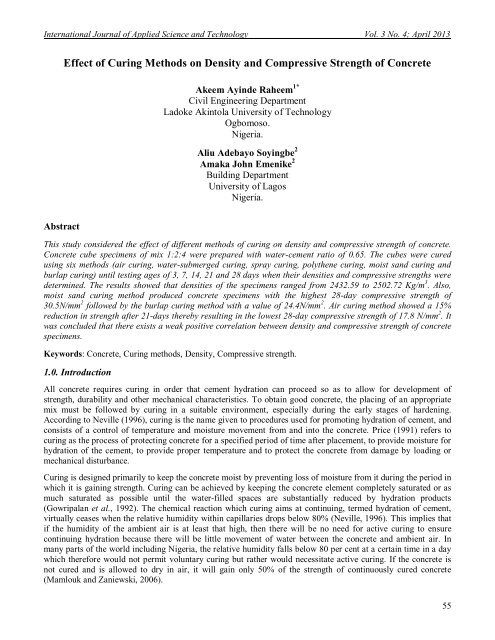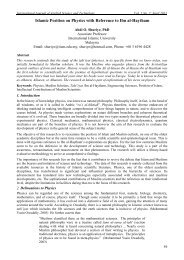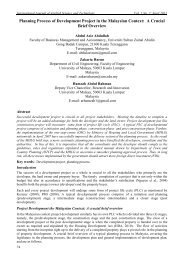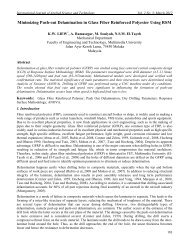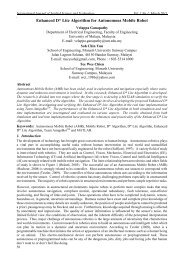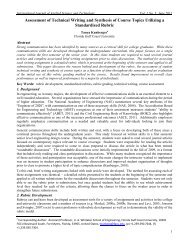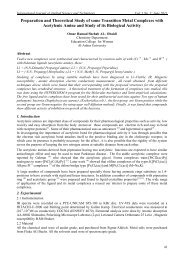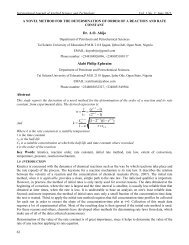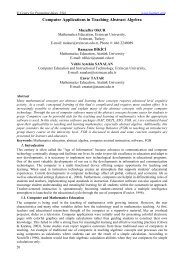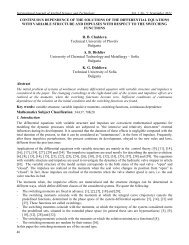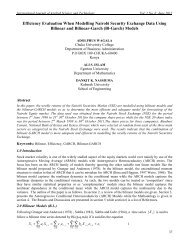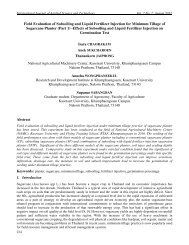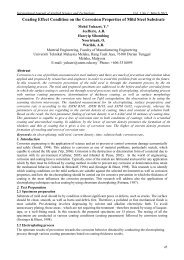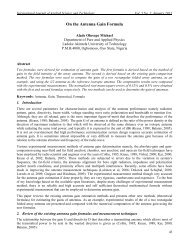Effect of Curing Methods on Density and Compressive Strength of ...
Effect of Curing Methods on Density and Compressive Strength of ...
Effect of Curing Methods on Density and Compressive Strength of ...
You also want an ePaper? Increase the reach of your titles
YUMPU automatically turns print PDFs into web optimized ePapers that Google loves.
Internati<strong>on</strong>al Journal <str<strong>on</strong>g>of</str<strong>on</strong>g> Applied Science <strong>and</strong> Technology Vol. 3 No. 4; April 2013<br />
<str<strong>on</strong>g>Effect</str<strong>on</strong>g> <str<strong>on</strong>g>of</str<strong>on</strong>g> <str<strong>on</strong>g>Curing</str<strong>on</strong>g> <str<strong>on</strong>g>Methods</str<strong>on</strong>g> <strong>on</strong> <strong>Density</strong> <strong>and</strong> <strong>Compressive</strong> <strong>Strength</strong> <str<strong>on</strong>g>of</str<strong>on</strong>g> C<strong>on</strong>crete<br />
Akeem Ayinde Raheem 1*<br />
Civil Engineering Department<br />
Ladoke Akintola University <str<strong>on</strong>g>of</str<strong>on</strong>g> Technology<br />
Ogbomoso.<br />
Nigeria.<br />
Aliu Adebayo Soyingbe 2<br />
Amaka John Emenike 2<br />
Building Department<br />
University <str<strong>on</strong>g>of</str<strong>on</strong>g> Lagos<br />
Nigeria.<br />
Abstract<br />
This study c<strong>on</strong>sidered the effect <str<strong>on</strong>g>of</str<strong>on</strong>g> different methods <str<strong>on</strong>g>of</str<strong>on</strong>g> curing <strong>on</strong> density <strong>and</strong> compressive strength <str<strong>on</strong>g>of</str<strong>on</strong>g> c<strong>on</strong>crete.<br />
C<strong>on</strong>crete cube specimens <str<strong>on</strong>g>of</str<strong>on</strong>g> mix 1:2:4 were prepared with water-cement ratio <str<strong>on</strong>g>of</str<strong>on</strong>g> 0.65. The cubes were cured<br />
using six methods (air curing, water-submerged curing, spray curing, polythene curing, moist s<strong>and</strong> curing <strong>and</strong><br />
burlap curing) until testing ages <str<strong>on</strong>g>of</str<strong>on</strong>g> 3, 7, 14, 21 <strong>and</strong> 28 days when their densities <strong>and</strong> compressive strengths were<br />
determined. The results showed that densities <str<strong>on</strong>g>of</str<strong>on</strong>g> the specimens ranged from 2432.59 to 2502.72 Kg/m 3 . Also,<br />
moist s<strong>and</strong> curing method produced c<strong>on</strong>crete specimens with the highest 28-day compressive strength <str<strong>on</strong>g>of</str<strong>on</strong>g><br />
30.5N/mm 2 followed by the burlap curing method with a value <str<strong>on</strong>g>of</str<strong>on</strong>g> 24.4N/mm 2 . Air curing method showed a 15%<br />
reducti<strong>on</strong> in strength after 21-days thereby resulting in the lowest 28-day compressive strength <str<strong>on</strong>g>of</str<strong>on</strong>g> 17.8 N/mm 2 . It<br />
was c<strong>on</strong>cluded that there exists a weak positive correlati<strong>on</strong> between density <strong>and</strong> compressive strength <str<strong>on</strong>g>of</str<strong>on</strong>g> c<strong>on</strong>crete<br />
specimens.<br />
Keywords: C<strong>on</strong>crete, <str<strong>on</strong>g>Curing</str<strong>on</strong>g> methods, <strong>Density</strong>, <strong>Compressive</strong> strength.<br />
1.0. Introducti<strong>on</strong><br />
All c<strong>on</strong>crete requires curing in order that cement hydrati<strong>on</strong> can proceed so as to allow for development <str<strong>on</strong>g>of</str<strong>on</strong>g><br />
strength, durability <strong>and</strong> other mechanical characteristics. To obtain good c<strong>on</strong>crete, the placing <str<strong>on</strong>g>of</str<strong>on</strong>g> an appropriate<br />
mix must be followed by curing in a suitable envir<strong>on</strong>ment, especially during the early stages <str<strong>on</strong>g>of</str<strong>on</strong>g> hardening.<br />
According to Neville (1996), curing is the name given to procedures used for promoting hydrati<strong>on</strong> <str<strong>on</strong>g>of</str<strong>on</strong>g> cement, <strong>and</strong><br />
c<strong>on</strong>sists <str<strong>on</strong>g>of</str<strong>on</strong>g> a c<strong>on</strong>trol <str<strong>on</strong>g>of</str<strong>on</strong>g> temperature <strong>and</strong> moisture movement from <strong>and</strong> into the c<strong>on</strong>crete. Price (1991) refers to<br />
curing as the process <str<strong>on</strong>g>of</str<strong>on</strong>g> protecting c<strong>on</strong>crete for a specified period <str<strong>on</strong>g>of</str<strong>on</strong>g> time after placement, to provide moisture for<br />
hydrati<strong>on</strong> <str<strong>on</strong>g>of</str<strong>on</strong>g> the cement, to provide proper temperature <strong>and</strong> to protect the c<strong>on</strong>crete from damage by loading or<br />
mechanical disturbance.<br />
<str<strong>on</strong>g>Curing</str<strong>on</strong>g> is designed primarily to keep the c<strong>on</strong>crete moist by preventing loss <str<strong>on</strong>g>of</str<strong>on</strong>g> moisture from it during the period in<br />
which it is gaining strength. <str<strong>on</strong>g>Curing</str<strong>on</strong>g> can be achieved by keeping the c<strong>on</strong>crete element completely saturated or as<br />
much saturated as possible until the water-filled spaces are substantially reduced by hydrati<strong>on</strong> products<br />
(Gowripalan et al., 1992). The chemical reacti<strong>on</strong> which curing aims at c<strong>on</strong>tinuing, termed hydrati<strong>on</strong> <str<strong>on</strong>g>of</str<strong>on</strong>g> cement,<br />
virtually ceases when the relative humidity within capillaries drops below 80% (Neville, 1996). This implies that<br />
if the humidity <str<strong>on</strong>g>of</str<strong>on</strong>g> the ambient air is at least that high, then there will be no need for active curing to ensure<br />
c<strong>on</strong>tinuing hydrati<strong>on</strong> because there will be little movement <str<strong>on</strong>g>of</str<strong>on</strong>g> water between the c<strong>on</strong>crete <strong>and</strong> ambient air. In<br />
many parts <str<strong>on</strong>g>of</str<strong>on</strong>g> the world including Nigeria, the relative humidity falls below 80 per cent at a certain time in a day<br />
which therefore would not permit voluntary curing but rather would necessitate active curing. If the c<strong>on</strong>crete is<br />
not cured <strong>and</strong> is allowed to dry in air, it will gain <strong>on</strong>ly 50% <str<strong>on</strong>g>of</str<strong>on</strong>g> the strength <str<strong>on</strong>g>of</str<strong>on</strong>g> c<strong>on</strong>tinuously cured c<strong>on</strong>crete<br />
(Mamlouk <strong>and</strong> Zaniewski, 2006).<br />
55
© Center for Promoting Ideas, USA www.ijastnet.com<br />
If c<strong>on</strong>crete is cured for <strong>on</strong>ly three days, it will reach about 60% <str<strong>on</strong>g>of</str<strong>on</strong>g> the strength <str<strong>on</strong>g>of</str<strong>on</strong>g> c<strong>on</strong>tinuously cured c<strong>on</strong>crete; if<br />
it is cured for seven days, it will reach 80% <str<strong>on</strong>g>of</str<strong>on</strong>g> the strength <str<strong>on</strong>g>of</str<strong>on</strong>g> c<strong>on</strong>tinuously cured c<strong>on</strong>crete. If curing stops for<br />
some time <strong>and</strong> then resumes again, the strength gain will also stop <strong>and</strong> reactivate (Mamlouk <strong>and</strong> Zaniewski,<br />
2006). If a c<strong>on</strong>crete is not well cured, particularly at the early age, it will not gain the required properties at<br />
desired level due to a lower degree <str<strong>on</strong>g>of</str<strong>on</strong>g> hydrati<strong>on</strong>, <strong>and</strong> would suffer from irreparable loss (Ramezanianpour <strong>and</strong><br />
Malhotra, 1995; Zain et al., 2000). Improper curing would entail insufficient moisture <strong>and</strong> this has been found to<br />
produce cracks, compromise strength, <strong>and</strong> reduce l<strong>on</strong>g-term durability (Wojcik <strong>and</strong> Fitzgarrald, 2001).<br />
It is a known fact that many other factors affect the development <str<strong>on</strong>g>of</str<strong>on</strong>g> strength <str<strong>on</strong>g>of</str<strong>on</strong>g> c<strong>on</strong>crete <strong>and</strong> c<strong>on</strong>sequently its<br />
durability other than curing or the curing technique applied. These factors include quality <strong>and</strong> quantity <str<strong>on</strong>g>of</str<strong>on</strong>g> cement<br />
used in a mix, grading <str<strong>on</strong>g>of</str<strong>on</strong>g> aggregates, maximum nominal size, shape <strong>and</strong> surface texture <str<strong>on</strong>g>of</str<strong>on</strong>g> aggregate (Arum <strong>and</strong><br />
Alhassan, 2005) water/cement ratios, degree <str<strong>on</strong>g>of</str<strong>on</strong>g> compacti<strong>on</strong> (Aluko, 2005) <strong>and</strong> the presence or otherwise <str<strong>on</strong>g>of</str<strong>on</strong>g> clayey<br />
particles <strong>and</strong> organic matter in the mix (Arum <strong>and</strong> Udoh, 2005). The scope <str<strong>on</strong>g>of</str<strong>on</strong>g> discussi<strong>on</strong> in this study is methods<br />
<str<strong>on</strong>g>of</str<strong>on</strong>g> curing c<strong>on</strong>crete.<br />
A number <str<strong>on</strong>g>of</str<strong>on</strong>g> curing techniques can be applied depending <strong>on</strong> various factors c<strong>on</strong>sidered <strong>on</strong> site or due to the<br />
c<strong>on</strong>structi<strong>on</strong> method. They range from the most popular water-submerged curing to moist s<strong>and</strong>, water-spray<br />
curing, polythene membrane sealing <strong>and</strong> steam curing (autoclaving). Also, there has been the introducti<strong>on</strong> <str<strong>on</strong>g>of</str<strong>on</strong>g><br />
membrane-forming curing agents/compounds which are widely accepted in developed nati<strong>on</strong>s because they can<br />
be applied quicker than sheets <strong>and</strong> require least amount <str<strong>on</strong>g>of</str<strong>on</strong>g> curing protecti<strong>on</strong>. They work by sealing the surface <str<strong>on</strong>g>of</str<strong>on</strong>g><br />
the c<strong>on</strong>crete but do not prevent complete evaporati<strong>on</strong> <str<strong>on</strong>g>of</str<strong>on</strong>g> mix water.<br />
It is against this background that this study seeks to assess the effect <str<strong>on</strong>g>of</str<strong>on</strong>g> different curing methods <strong>on</strong> the density<br />
<strong>and</strong> compressive strength <str<strong>on</strong>g>of</str<strong>on</strong>g> c<strong>on</strong>crete <strong>and</strong> to determine method(s) that is/are unsuitable which may impair the<br />
quality <str<strong>on</strong>g>of</str<strong>on</strong>g> the c<strong>on</strong>crete.<br />
2.0. Experimental Procedure<br />
2.1. Materials<br />
The materials used for the producti<strong>on</strong> <str<strong>on</strong>g>of</str<strong>on</strong>g> c<strong>on</strong>crete test specimens are ordinary Portl<strong>and</strong> cement, sharp s<strong>and</strong>, granite<br />
<strong>and</strong> tap water. Locally available crushed granite was used as coarse aggregates <strong>and</strong> sharp s<strong>and</strong> as fine aggregate.<br />
All aggregates were ensured to be free from deleterious substances such as organic impurities, clay <strong>and</strong> other<br />
unsound particles. Burham br<strong>and</strong> <str<strong>on</strong>g>of</str<strong>on</strong>g> ordinary Portl<strong>and</strong> cement was used as binder in this study.<br />
2.2. Preliminary Tests<br />
The grading <str<strong>on</strong>g>of</str<strong>on</strong>g> fine <strong>and</strong> coarse aggregates was determined in accordance with procedure in BS 1377 (1990), Part<br />
2:9.2. The specific gravity <strong>and</strong> moisture c<strong>on</strong>tent <str<strong>on</strong>g>of</str<strong>on</strong>g> the fine aggregates were also determined according to<br />
procedure in B.S. 1377 (1990).<br />
2.3. Preparati<strong>on</strong> <str<strong>on</strong>g>of</str<strong>on</strong>g> C<strong>on</strong>crete <strong>and</strong> Test Specimens<br />
A st<strong>and</strong>ard mix ratio <str<strong>on</strong>g>of</str<strong>on</strong>g> 1:2:4 was used. This is due to the fact that it is the comm<strong>on</strong>ly used ratio <strong>on</strong> c<strong>on</strong>structi<strong>on</strong><br />
sites for reinforced c<strong>on</strong>crete. Batching by weight was adopted. Casting <str<strong>on</strong>g>of</str<strong>on</strong>g> all specimens was carried out under<br />
same ambient c<strong>on</strong>diti<strong>on</strong>s <str<strong>on</strong>g>of</str<strong>on</strong>g> average temperature 27°C <strong>and</strong> 75% relative humidity. The water-cement ratio used<br />
for the mix was 0.65 <strong>and</strong> maintained for all subsequent mixes. Appropriate calculati<strong>on</strong>s <strong>and</strong> subsequent reducti<strong>on</strong><br />
<str<strong>on</strong>g>of</str<strong>on</strong>g> water to be used was made up<strong>on</strong> the determinati<strong>on</strong> <str<strong>on</strong>g>of</str<strong>on</strong>g> the moisture c<strong>on</strong>tent <str<strong>on</strong>g>of</str<strong>on</strong>g> the fine aggregate. The c<strong>on</strong>crete<br />
was prepared by h<strong>and</strong> mixing.<br />
The steel cube moulds for the test specimens were cleaned thoroughly <strong>and</strong> the interior faces oiled. The mixed<br />
c<strong>on</strong>crete was placed into the mould in three layers. Each layer <str<strong>on</strong>g>of</str<strong>on</strong>g> c<strong>on</strong>crete was compacted by not fewer than 35<br />
strokes <str<strong>on</strong>g>of</str<strong>on</strong>g> a 25mm diameter steel rod until full compacti<strong>on</strong> without segregati<strong>on</strong> was achieved. After compacti<strong>on</strong><br />
<str<strong>on</strong>g>of</str<strong>on</strong>g> the final layer, the top surface was finished by means <str<strong>on</strong>g>of</str<strong>on</strong>g> a h<strong>and</strong> trowel. The cubes were left undisturbed for<br />
about 24 hours in the laboratory to set <strong>and</strong> harden. At the end <str<strong>on</strong>g>of</str<strong>on</strong>g> this period, the c<strong>on</strong>crete cubes specimens were<br />
stripped <str<strong>on</strong>g>of</str<strong>on</strong>g> the moulds <strong>and</strong> placed in their respective curing envir<strong>on</strong>ments.<br />
56
Internati<strong>on</strong>al Journal <str<strong>on</strong>g>of</str<strong>on</strong>g> Applied Science <strong>and</strong> Technology Vol. 3 No. 4; April 2013<br />
2.4. <str<strong>on</strong>g>Curing</str<strong>on</strong>g> <str<strong>on</strong>g>Methods</str<strong>on</strong>g><br />
The c<strong>on</strong>crete specimens were cured using six different techniques until when their compressive strengths were<br />
determined at ages 3, 7, 14, 21 <strong>and</strong> 28 days. The curing techniques that were applied are:<br />
1. Water Submerged <str<strong>on</strong>g>Curing</str<strong>on</strong>g> (WSC): This involved the submersi<strong>on</strong> <str<strong>on</strong>g>of</str<strong>on</strong>g> the c<strong>on</strong>crete cube specimens in water.<br />
2. Spray <str<strong>on</strong>g>Curing</str<strong>on</strong>g> (SC): This involved the spraying <str<strong>on</strong>g>of</str<strong>on</strong>g> water <strong>on</strong> the c<strong>on</strong>crete cube specimens twice daily.<br />
3. Polythene <str<strong>on</strong>g>Curing</str<strong>on</strong>g> (PC): The specimens were covered with at least two layers <str<strong>on</strong>g>of</str<strong>on</strong>g> polythene membrane to<br />
prevent moisture movement from the c<strong>on</strong>crete specimens.<br />
4. Burlap <str<strong>on</strong>g>Curing</str<strong>on</strong>g> (BC): This involved covering the c<strong>on</strong>crete cube specimens underneath burlap which was<br />
kept wet periodically.<br />
5. Moist S<strong>and</strong> <str<strong>on</strong>g>Curing</str<strong>on</strong>g> (MSC): This involved burying the entire c<strong>on</strong>crete cube specimens in wet s<strong>and</strong> which<br />
was kept moist by wetting with water <strong>on</strong> a daily basis.<br />
6. Air <str<strong>on</strong>g>Curing</str<strong>on</strong>g> (AC): This served as the c<strong>on</strong>trol. It involved no form <str<strong>on</strong>g>of</str<strong>on</strong>g> active curing by just exposing the<br />
specimens to ambient air in the Laboratory.<br />
All the curing methods, except that <str<strong>on</strong>g>of</str<strong>on</strong>g> moist s<strong>and</strong> were carried out in the laboratory under the same envir<strong>on</strong>mental<br />
c<strong>on</strong>diti<strong>on</strong>s <str<strong>on</strong>g>of</str<strong>on</strong>g> 27°C temperature <strong>and</strong> 75% relative humidity. Moist s<strong>and</strong> curing was d<strong>on</strong>e outside the laboratory<br />
<strong>and</strong> exposed to varying envir<strong>on</strong>mental c<strong>on</strong>diti<strong>on</strong>.<br />
3.0. Results <strong>and</strong> Discussi<strong>on</strong><br />
3.1. Sieve Analysis<br />
The results <str<strong>on</strong>g>of</str<strong>on</strong>g> the sieve analysis for fine <strong>and</strong> coarse aggregates used are presented in Figure 1. It could be<br />
observed from the grading curves that the Coefficient <str<strong>on</strong>g>of</str<strong>on</strong>g> uniformity (Cu) <strong>and</strong> Coefficient <str<strong>on</strong>g>of</str<strong>on</strong>g> curvature (Cc) for the<br />
fine aggregates are 2.58 <strong>and</strong> 0.82 respectively. Thus, the s<strong>and</strong> can be said to be well graded. For the coarse<br />
aggregates, Cu <strong>and</strong> Cc are 2.1 <strong>and</strong> 1.1 respectively. According to Smith (1970), the coarse aggregate is well<br />
graded since it has a coefficient <str<strong>on</strong>g>of</str<strong>on</strong>g> curvature, Cc that falls between 1 <strong>and</strong> 3. The coarse aggregate falls under the<br />
category <str<strong>on</strong>g>of</str<strong>on</strong>g> nominal size <str<strong>on</strong>g>of</str<strong>on</strong>g> graded aggregates ranging from 20 to 5mm. The specific gravity <str<strong>on</strong>g>of</str<strong>on</strong>g> the s<strong>and</strong> is 2.66<br />
while the moisture c<strong>on</strong>tent is 16.8%.<br />
3.2. <strong>Density</strong> <str<strong>on</strong>g>of</str<strong>on</strong>g> C<strong>on</strong>crete Specimens<br />
Table 1 showed the mean density recorded by each curing method, the range <strong>and</strong> st<strong>and</strong>ard deviati<strong>on</strong>. The density<br />
<str<strong>on</strong>g>of</str<strong>on</strong>g> the specimens ranged from 2432.59 to 2502.72 Kg/m 3 . This lies within the range <str<strong>on</strong>g>of</str<strong>on</strong>g> 2200 to 2600 Kg/m 3<br />
specified as the density <str<strong>on</strong>g>of</str<strong>on</strong>g> normal weight c<strong>on</strong>crete (Neville, 2000). The moist s<strong>and</strong> curing method produced<br />
c<strong>on</strong>crete specimen with the highest mean density <str<strong>on</strong>g>of</str<strong>on</strong>g> 2502.72 Kg/m 3 , followed by the polythene <strong>and</strong> water<br />
submerged methods with mean values <str<strong>on</strong>g>of</str<strong>on</strong>g> 2484.94 Kg/m 3 <strong>and</strong> 2461.23 Kg/m 3 respectively. The polythene curing<br />
method produced the highest range <str<strong>on</strong>g>of</str<strong>on</strong>g> density <strong>and</strong> st<strong>and</strong>ard deviati<strong>on</strong> indicating that the method is highly<br />
unreliable. The specimens cured by burlap method produced the lowest range <str<strong>on</strong>g>of</str<strong>on</strong>g> density <strong>and</strong> st<strong>and</strong>ard deviati<strong>on</strong><br />
indicating that the method is reliable.<br />
3.3. <strong>Compressive</strong> <strong>Strength</strong> <str<strong>on</strong>g>of</str<strong>on</strong>g> C<strong>on</strong>crete Specimens<br />
Figure 4.2 showed the compressive strength <str<strong>on</strong>g>of</str<strong>on</strong>g> air-cured c<strong>on</strong>crete specimens. The air cured specimens showed an<br />
average compressive strength <str<strong>on</strong>g>of</str<strong>on</strong>g> 11.9, 16.6, 20.0, 20.9 <strong>and</strong> 17.8 N/mm 2 after 3, 7, 14 21 <strong>and</strong> 28 days <str<strong>on</strong>g>of</str<strong>on</strong>g> curing.<br />
57
© Center for Promoting Ideas, USA www.ijastnet.com<br />
British St<strong>and</strong>ard Test Sieves (mm)<br />
Figure 1: Particle Size distributi<strong>on</strong> curve for the S<strong>and</strong> <strong>and</strong> Granite used<br />
58
Internati<strong>on</strong>al Journal <str<strong>on</strong>g>of</str<strong>on</strong>g> Applied Science <strong>and</strong> Technology Vol. 3 No. 4; April 2013<br />
<str<strong>on</strong>g>Curing</str<strong>on</strong>g> method<br />
Air <str<strong>on</strong>g>Curing</str<strong>on</strong>g><br />
(C<strong>on</strong>trol)<br />
Water<br />
Submerged<br />
<str<strong>on</strong>g>Curing</str<strong>on</strong>g><br />
Polythene<br />
<str<strong>on</strong>g>Curing</str<strong>on</strong>g><br />
Moist S<strong>and</strong><br />
<str<strong>on</strong>g>Curing</str<strong>on</strong>g><br />
Burlap <str<strong>on</strong>g>Curing</str<strong>on</strong>g><br />
Spray <str<strong>on</strong>g>Curing</str<strong>on</strong>g><br />
Table 1: Relati<strong>on</strong>ship between <str<strong>on</strong>g>Curing</str<strong>on</strong>g> <str<strong>on</strong>g>Methods</str<strong>on</strong>g> <strong>and</strong> <strong>Density</strong> <str<strong>on</strong>g>of</str<strong>on</strong>g> Specimens<br />
<str<strong>on</strong>g>Curing</str<strong>on</strong>g> period<br />
(days)<br />
<strong>Density</strong><br />
(Kg/m 3 )<br />
Mean<br />
(Kg/m 3 )<br />
Range<br />
(Kg/m 3 )<br />
St<strong>and</strong>ard<br />
Deviati<strong>on</strong><br />
3 2469.14<br />
7 2424.69<br />
14 2459.26 2442.47 69.14 29.13<br />
21 2459.26<br />
28 2400.00<br />
3 2459.26<br />
7 2459.26<br />
14 2469.14 2461.23 118.52 42.13<br />
21 2400.00<br />
28 2518.52<br />
3 2469.14<br />
7 2390.12<br />
14 2429.63 2484.94 207.41 83.40<br />
21 2597.53<br />
28 2538.27<br />
3 2518.52<br />
7 2518.52<br />
14 2439.51 2502.72 79.01 35.34<br />
21 2518.52<br />
28 2518.52<br />
3 2459.26<br />
7 2419.75<br />
14 2434.57 2432.59 39.51 16.23<br />
21 2429.63<br />
28 2419.75<br />
3 2404.94<br />
7 2439.51<br />
14 2498.77 2450.37 93.83 38.00<br />
21 2479.01<br />
28 2429.63<br />
Figure 2: <str<strong>on</strong>g>Effect</str<strong>on</strong>g> <str<strong>on</strong>g>of</str<strong>on</strong>g> air-curing <strong>on</strong> the compressive strength <str<strong>on</strong>g>of</str<strong>on</strong>g> c<strong>on</strong>crete<br />
59
© Center for Promoting Ideas, USA www.ijastnet.com<br />
The 28-day strength recorded a 15% decrease in strength relative to the 21-day strength. This is similar to the<br />
results obtained by Safan <strong>and</strong> Kohoutková (2001) in which the specimens were exposed to outside envir<strong>on</strong>mental<br />
c<strong>on</strong>diti<strong>on</strong>s <strong>and</strong> 15% reducti<strong>on</strong> in strength was recorded between the 7 <strong>and</strong> 28-day strength. The reducti<strong>on</strong> in<br />
strength recorded between the 21 st <strong>and</strong> 28 th day <str<strong>on</strong>g>of</str<strong>on</strong>g> curing can be attributed to the total c<strong>on</strong>sumpti<strong>on</strong> <str<strong>on</strong>g>of</str<strong>on</strong>g> all the mix<br />
water in the c<strong>on</strong>crete specimen which halted the cement hydrati<strong>on</strong> process.<br />
The compressive strength <str<strong>on</strong>g>of</str<strong>on</strong>g> c<strong>on</strong>crete specimens cured by submersi<strong>on</strong> in water is presented in Figure 3. It could<br />
be observed from the figure that an average compressive strength <str<strong>on</strong>g>of</str<strong>on</strong>g> 16.6, 17.3, 19.0, 20.3 <strong>and</strong> 23.6 N/mm 2 were<br />
recorded after 3, 7, 14, 21 <strong>and</strong> 28 days <str<strong>on</strong>g>of</str<strong>on</strong>g> curing respectively.<br />
Figure 3: <str<strong>on</strong>g>Effect</str<strong>on</strong>g> <str<strong>on</strong>g>of</str<strong>on</strong>g> Water-submerged curing <strong>on</strong> the compressive strength <str<strong>on</strong>g>of</str<strong>on</strong>g> c<strong>on</strong>crete<br />
The specimens recorded 70% <str<strong>on</strong>g>of</str<strong>on</strong>g> its 28-day strength just after 3 days <str<strong>on</strong>g>of</str<strong>on</strong>g> curing. The strength <str<strong>on</strong>g>of</str<strong>on</strong>g> the specimens<br />
c<strong>on</strong>tinually increased during the 28 days <str<strong>on</strong>g>of</str<strong>on</strong>g> curing as water, which allows c<strong>on</strong>tinuous cement hydrati<strong>on</strong> was<br />
present in abundance thereby ensuring 100% relative humidity. This result is similar to those obtained by Raheem<br />
<strong>and</strong> Aderounmu (2002), Adesanya <strong>and</strong> Raheem (2002) <strong>and</strong> Raheem <strong>and</strong> Abimbola (2006).<br />
Figure 4 showed the compressive strength <str<strong>on</strong>g>of</str<strong>on</strong>g> c<strong>on</strong>crete specimens cured using the polythene curing method. The<br />
figure indicated that the average compressive strength <str<strong>on</strong>g>of</str<strong>on</strong>g> the specimens at 3, 7, 14, 21 <strong>and</strong> 28 days <str<strong>on</strong>g>of</str<strong>on</strong>g> curing are<br />
15.0, 16.1, 18.5, 19.3 <strong>and</strong> 23.0 N/mm 2 respectively. The specimens attained 70% <str<strong>on</strong>g>of</str<strong>on</strong>g> their 28 th day strength after 7<br />
days <str<strong>on</strong>g>of</str<strong>on</strong>g> curing.<br />
The compressive strength <str<strong>on</strong>g>of</str<strong>on</strong>g> c<strong>on</strong>crete specimens cured using the moist s<strong>and</strong> method is presented in Figure 5. The<br />
average compressive strength recorded are 18.1, 18.2, 19.6, 22.5 <strong>and</strong> 30.5N/mm 2 at 3, 7, 14, 21 <strong>and</strong> 28 days<br />
respectively.<br />
60<br />
Figure 4: <str<strong>on</strong>g>Effect</str<strong>on</strong>g> <str<strong>on</strong>g>of</str<strong>on</strong>g> polythene curing <strong>on</strong> the compressive strength <str<strong>on</strong>g>of</str<strong>on</strong>g> c<strong>on</strong>crete
Internati<strong>on</strong>al Journal <str<strong>on</strong>g>of</str<strong>on</strong>g> Applied Science <strong>and</strong> Technology Vol. 3 No. 4; April 2013<br />
Figure 5: <str<strong>on</strong>g>Effect</str<strong>on</strong>g> <str<strong>on</strong>g>of</str<strong>on</strong>g> moist s<strong>and</strong> curing <strong>on</strong> the compressive strength <str<strong>on</strong>g>of</str<strong>on</strong>g> c<strong>on</strong>crete.<br />
This method was the <strong>on</strong>ly <strong>on</strong>e executed outside the laboratory <strong>and</strong> was pr<strong>on</strong>e to varying envir<strong>on</strong>mental<br />
c<strong>on</strong>diti<strong>on</strong>s. The high compressive strength recorded at the 28 th day can be attributed to the suitable weather<br />
c<strong>on</strong>diti<strong>on</strong>(average daily ambient temperature <str<strong>on</strong>g>of</str<strong>on</strong>g> 32°C which was higher than that <str<strong>on</strong>g>of</str<strong>on</strong>g> the laboratory <str<strong>on</strong>g>of</str<strong>on</strong>g> 27°C)<br />
witnessed throughout the curing period. However, the c<strong>on</strong>crete cube specimens cured by this method had their<br />
entire surface marred by the colour <str<strong>on</strong>g>of</str<strong>on</strong>g> the s<strong>and</strong> grains. The discolourati<strong>on</strong> <str<strong>on</strong>g>of</str<strong>on</strong>g> the c<strong>on</strong>crete surface makes the<br />
method unsuitable for pre-cast c<strong>on</strong>crete members which usually do not require any finishing.<br />
Figure 6 showed the compressive strength <str<strong>on</strong>g>of</str<strong>on</strong>g> c<strong>on</strong>crete specimens cured using the burlap curing method. After 3<br />
days <str<strong>on</strong>g>of</str<strong>on</strong>g> curing, the specimens recorded average compressive strength <str<strong>on</strong>g>of</str<strong>on</strong>g> 14.5 N/mm 2 . This increased to 15.7<br />
N/mm 2 at 7 days, 17.3 N/mm 2 at 14 days, 18.7 N/mm 2 at 21 days <strong>and</strong> 24.4 N/mm 2 at 28 days.<br />
The compressive strength <str<strong>on</strong>g>of</str<strong>on</strong>g> c<strong>on</strong>crete specimens cured using the water spray curing method is presented in Figure<br />
7. It could be observed from the figure that an average compressive strength <str<strong>on</strong>g>of</str<strong>on</strong>g> 13.6, 15.0, 17.2, 19.7 <strong>and</strong> 23.6<br />
N/mm 2 were recorded after 3, 7, 14, 21 <strong>and</strong> 28 days <str<strong>on</strong>g>of</str<strong>on</strong>g> curing respectively. All the methods <str<strong>on</strong>g>of</str<strong>on</strong>g> curing, except air<br />
curing (the c<strong>on</strong>trol) produced c<strong>on</strong>crete specimens that met the minimum compressive strength <str<strong>on</strong>g>of</str<strong>on</strong>g> 21 N/mm 2 at 28<br />
days specified by Nati<strong>on</strong>al Building Code (2006). Air curing with compressive strength <str<strong>on</strong>g>of</str<strong>on</strong>g> 17.8N/mm 2 has the<br />
lowest strength while Moist s<strong>and</strong> curing recorded the highest strength <str<strong>on</strong>g>of</str<strong>on</strong>g> 30.5 N/mm 2 .<br />
3.4. Relati<strong>on</strong>ship between <strong>Density</strong> <strong>and</strong> <strong>Compressive</strong> <strong>Strength</strong> <str<strong>on</strong>g>of</str<strong>on</strong>g> Specimens<br />
Table 2 seeks to establish the relati<strong>on</strong>ship between average densities <str<strong>on</strong>g>of</str<strong>on</strong>g> specimens cured via different curing<br />
methods <strong>and</strong> their respective compressive strength. This was d<strong>on</strong>e through the determinati<strong>on</strong> <str<strong>on</strong>g>of</str<strong>on</strong>g> Pears<strong>on</strong>’s<br />
Correlati<strong>on</strong> Coefficient.<br />
Figure 6: <str<strong>on</strong>g>Effect</str<strong>on</strong>g> <str<strong>on</strong>g>of</str<strong>on</strong>g> burlap curing <strong>on</strong> the compressive strength <str<strong>on</strong>g>of</str<strong>on</strong>g> c<strong>on</strong>crete<br />
61
© Center for Promoting Ideas, USA www.ijastnet.com<br />
Figure 7: <str<strong>on</strong>g>Effect</str<strong>on</strong>g> <str<strong>on</strong>g>of</str<strong>on</strong>g> spray curing <strong>on</strong> the compressive strength <str<strong>on</strong>g>of</str<strong>on</strong>g> c<strong>on</strong>crete<br />
<str<strong>on</strong>g>Curing</str<strong>on</strong>g><br />
Method<br />
Air- <str<strong>on</strong>g>Curing</str<strong>on</strong>g><br />
Water<br />
Submerged<br />
curing<br />
Polythene<br />
curing<br />
Moist<br />
curing<br />
Burlap<br />
curing<br />
s<strong>and</strong><br />
Spray curing<br />
<str<strong>on</strong>g>Curing</str<strong>on</strong>g><br />
Period<br />
Table 2: Relati<strong>on</strong>ship between <strong>Density</strong> <strong>and</strong> <strong>Compressive</strong> <strong>Strength</strong><br />
Average<br />
<strong>Density</strong><br />
(Kg/m 3 )<br />
<strong>Compressive</strong><br />
strength<br />
(N/mm 2 )<br />
3 2469.1 11.9 11 29 319 121 841<br />
7 2424.7 16.6 24 22.5 540 576 506.25<br />
14 2459.3 20.0 15 9 135 225 81<br />
21 2459.3 20.9 15 7 105 225 49<br />
28 2400.0 17.8 28.5 18 513 812.25 324<br />
3 2459.3 16.6 15 22.5 337.5 225 506.25<br />
7 2459.3 17.3 15 19.5 292.5 225 380.25<br />
14 2469.1 19.0 11 13 143 121 169<br />
21 2400.0 20.3 28.5 8 228 812.25 64<br />
28 2518.5 23.6 5 3.5 17.5 25 12.25<br />
3 2469.1 15.0 11 26.5 291.5 121 702.25<br />
7 2390.1 16.1 30 24 720 900 576<br />
14 2429.6 18.5 22 15 330 484 225<br />
21 2597.5 19.3 1 12 12 1 144<br />
28 2538.3 23.0 2 5 10 4 25<br />
3 2518.5 18.1 5 17 85 25 289<br />
7 2518.5 18.2 5 16 80 25 256<br />
14 2439.5 19.6 18.5 11 203.5 342.25 121<br />
21 2518.5 22.5 5 6 30 25 36<br />
28 2518.5 30.5 5 1 5 25 1<br />
3 2459.3 14.5 15 27 405 225 729<br />
7 2419.8 15.7 25.5 25 637.5 650.25 625<br />
14 2434.6 17.3 20 19.5 390 400 380.25<br />
21 2429.6 18.7 22 14 308 484 196<br />
28 2419.8 24.4 25.5 2 51 650.25 4<br />
3 2404.9 13.6 27 28 756 729 784<br />
7 2439.5 15.0 18.5 26.5 490.25 342.25 702.25<br />
14 2498.8 17.2 8 21 168 64 441<br />
21 2479.0 19.7 9 10 90 81 100<br />
28 2429.6 23.6 22 3.5 77 484 12.25<br />
465 462 7770.25 9429.5 9282<br />
The Pears<strong>on</strong>’s correlati<strong>on</strong> was used to determine the relati<strong>on</strong>ship between the set <str<strong>on</strong>g>of</str<strong>on</strong>g> data. The rank assigned each<br />
member <str<strong>on</strong>g>of</str<strong>on</strong>g> the set (i.e. average density <strong>and</strong> compressive strength) are from the highest to the lowest. Where equal<br />
values in a set <str<strong>on</strong>g>of</str<strong>on</strong>g> data exist, the same rank has been assigned to each <str<strong>on</strong>g>of</str<strong>on</strong>g> the equal value which is the average <str<strong>on</strong>g>of</str<strong>on</strong>g><br />
their positi<strong>on</strong>s in the ascending order <str<strong>on</strong>g>of</str<strong>on</strong>g> the values.<br />
62
Internati<strong>on</strong>al Journal <str<strong>on</strong>g>of</str<strong>on</strong>g> Applied Science <strong>and</strong> Technology Vol. 3 No. 4; April 2013<br />
Since the value <str<strong>on</strong>g>of</str<strong>on</strong>g> falls between 0 <strong>and</strong> +0.5, it implies that there exists a weak positive correlati<strong>on</strong> between the<br />
densities <strong>and</strong> compressive strengths <str<strong>on</strong>g>of</str<strong>on</strong>g> the c<strong>on</strong>crete specimens. This means that as the density <str<strong>on</strong>g>of</str<strong>on</strong>g> the c<strong>on</strong>crete<br />
specimen increases, there is a tendency for the compressive strength to also increase.<br />
4.0. C<strong>on</strong>clusi<strong>on</strong><br />
The following c<strong>on</strong>clusi<strong>on</strong>s are drawn based <strong>on</strong> the results obtained from the various tests <strong>and</strong> discussi<strong>on</strong> <str<strong>on</strong>g>of</str<strong>on</strong>g><br />
findings:<br />
1. Based <strong>on</strong> the density, the specimens fall into the category <str<strong>on</strong>g>of</str<strong>on</strong>g> normal weight c<strong>on</strong>crete.<br />
2. Moist s<strong>and</strong> curing method produced specimens with the highest compressive strength while Air curing<br />
produced the lowest.<br />
3. All the methods <str<strong>on</strong>g>of</str<strong>on</strong>g> curing c<strong>on</strong>sidered, except air curing (the c<strong>on</strong>trol) produced c<strong>on</strong>crete specimens that met<br />
the minimum compressive strength specified by the available code.<br />
4. There exists a weak positive correlati<strong>on</strong> between density <strong>and</strong> compressive strength <str<strong>on</strong>g>of</str<strong>on</strong>g> c<strong>on</strong>crete.<br />
63
© Center for Promoting Ideas, USA www.ijastnet.com<br />
References<br />
Adesanya, D. A. <strong>and</strong> Raheem, A. A. (2002). The <str<strong>on</strong>g>Effect</str<strong>on</strong>g> <str<strong>on</strong>g>of</str<strong>on</strong>g> Different Br<strong>and</strong>s <str<strong>on</strong>g>of</str<strong>on</strong>g> Ordinary Portl<strong>and</strong> Cement <strong>on</strong> the<br />
<strong>Compressive</strong> <strong>Strength</strong> <str<strong>on</strong>g>of</str<strong>on</strong>g> C<strong>on</strong>crete. Journal <str<strong>on</strong>g>of</str<strong>on</strong>g> Civil Engineering, Sec<strong>on</strong>d Editi<strong>on</strong>, November, 37-43.<br />
Aluko, O.S.(2005). Comparative Assessment <str<strong>on</strong>g>of</str<strong>on</strong>g> C<strong>on</strong>crete <str<strong>on</strong>g>Curing</str<strong>on</strong>g> <str<strong>on</strong>g>Methods</str<strong>on</strong>g>. Unpublished Post Graduate Diploma<br />
Thesis, Federal University <str<strong>on</strong>g>of</str<strong>on</strong>g> Technology, Akure, Nigeria.<br />
Arum, C. <strong>and</strong> Alhassan, Y.A. (2005). Combined <str<strong>on</strong>g>Effect</str<strong>on</strong>g> <str<strong>on</strong>g>of</str<strong>on</strong>g> Aggregate Shape, Texture <strong>and</strong> Size <strong>on</strong> C<strong>on</strong>crete<br />
<strong>Strength</strong>. Journal <str<strong>on</strong>g>of</str<strong>on</strong>g> Science, Engineering <strong>and</strong> Technology.13(2), 6876-6887.<br />
Arum, C. <strong>and</strong> Udoh, I.(2005). <str<strong>on</strong>g>Effect</str<strong>on</strong>g> <str<strong>on</strong>g>of</str<strong>on</strong>g> dust inclusi<strong>on</strong> in aggregate <strong>on</strong> the compressive strength <str<strong>on</strong>g>of</str<strong>on</strong>g> c<strong>on</strong>crete.<br />
Journal <str<strong>on</strong>g>of</str<strong>on</strong>g> Science, Engineering <strong>and</strong> Technology. 12(2), 6170-6184.<br />
British St<strong>and</strong>ard Instituti<strong>on</strong> (1990) <str<strong>on</strong>g>Methods</str<strong>on</strong>g> <str<strong>on</strong>g>of</str<strong>on</strong>g> Testing <str<strong>on</strong>g>of</str<strong>on</strong>g> Soils for Civil Engineering Purposes, BS 1377,<br />
L<strong>on</strong>d<strong>on</strong>, British St<strong>and</strong>ard Instituti<strong>on</strong><br />
Gowripalan, N., Cabrera, J.G.; A.R, Cusens <strong>and</strong> Wainwright, P.J. (1992) <str<strong>on</strong>g>Effect</str<strong>on</strong>g> <str<strong>on</strong>g>of</str<strong>on</strong>g> <str<strong>on</strong>g>Curing</str<strong>on</strong>g> <strong>on</strong> Durability,<br />
Durable C<strong>on</strong>crete, ACI Compilati<strong>on</strong> 24. American C<strong>on</strong>crete Institute, Farmingt<strong>on</strong> Hills, Michigan, USA,<br />
47-54.<br />
Mamlouk, M.S. <strong>and</strong> Zaniewski, J.P (2006). Materials for Civil <strong>and</strong> C<strong>on</strong>structi<strong>on</strong> Engineers. 2 nd ed., New Jersey:<br />
Pears<strong>on</strong> Prentice Hall.<br />
Neville, A. M. (1996). Properties <str<strong>on</strong>g>of</str<strong>on</strong>g> C<strong>on</strong>crete, 4 th ed., USA, New York: John Wiley <strong>and</strong> S<strong>on</strong>s<br />
Neville, A. M. (2000). Properties <str<strong>on</strong>g>of</str<strong>on</strong>g> C<strong>on</strong>crete, 4 th ed., Engl<strong>and</strong>: L<strong>on</strong>gman.<br />
Price, W. H. (1991) Factors influencing C<strong>on</strong>crete <strong>Strength</strong>. J. Am. C<strong>on</strong>crete Institute.<br />
Raheem, A. A. <strong>and</strong> Abimbola, S. A. A. (2006). <str<strong>on</strong>g>Effect</str<strong>on</strong>g> <str<strong>on</strong>g>of</str<strong>on</strong>g> Specimen Size <strong>on</strong> the <strong>Compressive</strong> <strong>Strength</strong> <str<strong>on</strong>g>of</str<strong>on</strong>g><br />
C<strong>on</strong>crete. USEP, Journal <str<strong>on</strong>g>of</str<strong>on</strong>g> Research Informati<strong>on</strong> in Civil Engineering (RICE), 3 (1), 55-64.<br />
Raheem A. A. <strong>and</strong> Aderounmu O. M. (2002). The <str<strong>on</strong>g>Effect</str<strong>on</strong>g> <str<strong>on</strong>g>of</str<strong>on</strong>g> Aggregate Sizes <strong>on</strong> the <strong>Strength</strong> <str<strong>on</strong>g>of</str<strong>on</strong>g> C<strong>on</strong>crete. Journal<br />
<str<strong>on</strong>g>of</str<strong>on</strong>g> Science, Engineering <strong>and</strong> Technology (JSET), 9 (2), 4041-4051.<br />
Ramezanianpour, A.A. <strong>and</strong> V.M. Malhotra,(1995). <str<strong>on</strong>g>Effect</str<strong>on</strong>g> <str<strong>on</strong>g>of</str<strong>on</strong>g> <str<strong>on</strong>g>Curing</str<strong>on</strong>g> <strong>on</strong> the <strong>Compressive</strong> <strong>Strength</strong>, Resistance to<br />
Chloride-I<strong>on</strong> Penetrati<strong>on</strong> <strong>and</strong> Porosity <str<strong>on</strong>g>of</str<strong>on</strong>g> C<strong>on</strong>cretes Incorporating Slag, Fly Ash or Silica Fume. Cement<br />
<strong>and</strong> C<strong>on</strong>crete Composites. 17(2), 125-133.<br />
Safan, M. <strong>and</strong> Kohoutková, A. (2001). Influence <str<strong>on</strong>g>of</str<strong>on</strong>g> Different Drying C<strong>on</strong>diti<strong>on</strong>s <strong>on</strong> High <strong>Strength</strong> C<strong>on</strong>crete, Acta<br />
Polytechnica. 41(3), 24-28.<br />
Safiuddin, M.D.,Raman, S.N. <strong>and</strong> Zain, M.F.M. (2007). <str<strong>on</strong>g>Effect</str<strong>on</strong>g> <str<strong>on</strong>g>of</str<strong>on</strong>g> Different <str<strong>on</strong>g>Curing</str<strong>on</strong>g> <str<strong>on</strong>g>Methods</str<strong>on</strong>g> <strong>on</strong> the properties <str<strong>on</strong>g>of</str<strong>on</strong>g><br />
Microsilica C<strong>on</strong>crete. Australian Journal <str<strong>on</strong>g>of</str<strong>on</strong>g> Basic <strong>and</strong> Applied Sciences. 1(2), 87-95.<br />
Wojcik, G.S., <strong>and</strong> Fitzjarrald, D.R. (2001). Energy Balances <str<strong>on</strong>g>of</str<strong>on</strong>g> <str<strong>on</strong>g>Curing</str<strong>on</strong>g> C<strong>on</strong>crete Bridge Decks. Journal <str<strong>on</strong>g>of</str<strong>on</strong>g><br />
Applied Meteorology, 40(11).<br />
Zain, M.F.M., M. Safiuddin <strong>and</strong> K.M. Yus<str<strong>on</strong>g>of</str<strong>on</strong>g>, (2000). Influence <str<strong>on</strong>g>of</str<strong>on</strong>g> Different <str<strong>on</strong>g>Curing</str<strong>on</strong>g> C<strong>on</strong>diti<strong>on</strong>s <strong>on</strong> the <strong>Strength</strong><br />
<strong>and</strong> Durability <str<strong>on</strong>g>of</str<strong>on</strong>g> High Performance C<strong>on</strong>crete. In the Proceedings <str<strong>on</strong>g>of</str<strong>on</strong>g> the Fourth ACI Internati<strong>on</strong>al<br />
C<strong>on</strong>ference <strong>on</strong> Repair, Rehabilitati<strong>on</strong> <strong>and</strong> Maintenance, ACI SP-193, American C<strong>on</strong>crete Institute.<br />
Farmingt<strong>on</strong> Hills, Michigan, USA. 275-292.<br />
64


